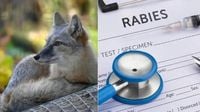Rabies, one of the world’s deadliest but most preventable viral diseases, is making a troubling comeback across the United States. Health officials and veterinarians are sounding the alarm as outbreaks among wildlife surge in several states, and the number of human fatalities has reached its highest point in years. The Centers for Disease Control and Prevention (CDC) reports that at least six people have died from rabies in the past 12 months—a sharp spike that has not been seen in recent memory.
According to the CDC, rabies activity is resurging in regions that had not seen cases for years. Wildlife outbreaks have been confirmed in New York’s Nassau and Suffolk counties, Cape Cod in Massachusetts, and across a swath of states including Alaska, Arizona, California, Indiana, Kentucky, Maine, North Carolina, Oregon, and Vermont. Dr. Ryan Wallace, who leads the CDC’s rabies team, put it plainly: “We are currently tracking 15 different likely outbreaks.” He added, “There are parts of the United States where it does seem like we’re getting more calls and more reports. Whether those numbers are truly significant increases, we can only tell at the end of the year. But right now, at peak rabies season, it does seem like activity is higher.” (MedicalNewsToday)
The CDC notes that about 4,000 animal rabies cases occur annually in the United States, with more than 90 percent found in wildlife such as bats, raccoons, skunks, and foxes. Bats, in particular, remain the most frequent source of human infection, as reported by Times Now News. While mass vaccination campaigns have dramatically reduced rabies risk from household pets—especially dogs—the persistent presence of the virus among wildlife continues to pose a significant public health threat.
Recent developments in New York’s Nassau County illustrate the growing concern. After years without a single reported case, local officials declared an “imminent public health threat” when 25 rabid animals were detected, mostly raccoons and feral cats. Neighboring Suffolk County also reported its first rabies case since 2009. The outbreaks are not limited to the Northeast. In Franklin County, North Carolina, rabies cases in wildlife have doubled year-on-year. Scott LaVigne, the county’s health director, explained the context: “For the number of confirmed cases to go up 100%, and we’re not even over this year’s rabies season, that’s a big deal. The population of Franklin County since 2010 has increased 35%, and those people have to live somewhere. And so you’re seeing increased land development and housing tracts going in.” (LADbible)
Experts attribute the rise in rabies activity to several overlapping factors. Urban growth and new housing developments are shrinking wild animal habitats, bringing wildlife—and the diseases they carry—into closer contact with humans. Enhanced disease surveillance is also catching more cases, but the underlying reality is that declining wildlife habitats are pushing animals into suburban and urban areas, increasing the risk of transmission. “We’re not even through the current rabies season. That’s a big deal,” said LaVigne, highlighting the urgency of the situation.
Another complicating trend is a worrying drop in pet vaccination rates. Veterinarians are increasingly concerned about vaccine skepticism among pet owners. A 2023 study published in the journal Vaccine found that nearly 40 percent of Americans believed canine vaccines were unsafe, and 37 percent feared these shots could cause cognitive problems like autism. Dr. Gabriella Motta, a co-author of the study, said, “If vaccination rates continue to fall, we may begin seeing rabies not just in wildlife, but in household pets too. We’re sounding the alarm.” (NBC News)
The consequences of these trends are stark. While only 17 human rabies cases have been reported nationwide over the past decade, six occurred in the last 12 months alone—a sudden and deeply concerning spike. Once symptoms appear, rabies is almost always fatal. The disease attacks the central nervous system, with early symptoms resembling the flu—fever, headache, and weakness. But it rapidly progresses to neurological symptoms like confusion, agitation, hallucinations, swallowing difficulties, partial paralysis, convulsions, excessive saliva production, and the classic “fear of water” (hydrophobia). As the World Health Organization notes, “Rabies is virtually 100% fatal once the symptoms are known.”
Yet, rabies is also one of the most preventable infectious diseases. The key is early intervention. Each year, more than a million Americans are checked for possible exposure to the rabies virus, and over 100,000 receive a series of vaccines—known as post-exposure prophylaxis (PEP)—to prevent the life-threatening infection. PEP is nearly always effective if administered promptly after exposure. The CDC and public health officials urge Americans to take several basic but critical steps: vaccinate pets regularly, avoid contact with wild or stray animals, wash wounds thoroughly and seek medical attention after any bite or scratch, and report unusual animal behavior to local health departments.
The CDC’s Dr. Wallace emphasized the importance of vigilance, especially as the country moves through peak rabies season. “There are parts of the United States where it does seem like we’re getting more calls and more reports,” he said, noting increases in rabid foxes in the West and rabid bats across the country. “Whether those numbers are truly significant increases, we can only tell at the end of the year. But right now, at peak rabies season, it does seem like activity is higher.”
Rabies exists in every U.S. state except Hawaii. While dogs used to be the main carriers, the risk from pets has plummeted thanks to widespread vaccination campaigns. However, the ongoing threat from wildlife means that public education and early vaccination remain the best defenses. The CDC estimates that the global cost of rabies—including lost lives, medical care, and psychological trauma—reaches about $8.6 billion per year.
As outbreaks continue to unfold, the message from health officials is clear: rabies may be rare, but it is deadly and, above all, preventable. Americans are urged to stay vigilant, protect their pets, and act swiftly if exposed. The resurgence of rabies serves as a sobering reminder that the battle against this ancient foe is far from over.

